PONTIAC FIERO 1988 Service Repair Manual
Manufacturer: PONTIAC, Model Year: 1988, Model line: FIERO, Model: PONTIAC FIERO 1988Pages: 1825, PDF Size: 99.44 MB
Page 701 of 1825

6E3-A-48 2.8L (VIN S) DRIVEABILITY AND EMISSIONS
DISTRIBUTOR
CODE 42
ELECTRONIC SPARK TIMING (EST) FAULT
2.8L (VIN S) ""F3"lES (PORT)
Circuit Description:
When the system is running on the ignition module, that is, no voltage on the bypass line, the ignition
module grounds the EST signal. The ECM expects to see no voltage on the EST Line during this condition.
If it
sees a voltage, it sets Code 42 and will not go into the EST mode.
When the rpm for EST is reached (about 400
rpm), and bypass voltage applied, the EST should on longer be
grounded in the ignition module so the EST voltage should be varying.
If the bypass line is open or grounded, the ignition module will not switch to EST mode so the EST voltage
will be low and Code 42 will be set.
If the EST line is grounded, the ignition module will switch to EST, but because the line is grounded there
will be no EST signal.
A Code 42 will be set.
f est Description: Numbers below refer to circled
numbers on the diagnostic chart.
1. Code 42 means the ECM has seen an open or short
to ground in the EST or bypass circuits. This test
confirms Code 42 and that the fault causing the
code is present.
2. Checks
for a normal EST ground path through the
ignition module, An EST CKT 423 shorted to
ground will also read less than 500 ohms;
however, this will be checked later.
3. As the test light voltage touches CKT 424, the
module should switch causing the ohmmeter to
"overrange" if the meter is in the 1000-2000
oh~ns
position. Selecting the 10-20,000 ohms position
will indicate above 5000 ohms. The important
thing is that the
moclule "switched" 4.
The module did not switch and this step checks for:
s EST CKT 423 shorted to ground.
@ Bypass CKrI' 424 open.
@ Faulty ignition module connection or module.
5. Confirms that Code 42 is a faulty ECM and not an
intermittent in
CKTs 423 or 424.
Diagnostic Aids:
The "Scan" tool does not have any ability to help
diagnose a Code 42 problem.
A PROM not fully seated in the ECM can result in
a Code 42.
Refer to "Intermittents" in Section "B".
Page 702 of 1825
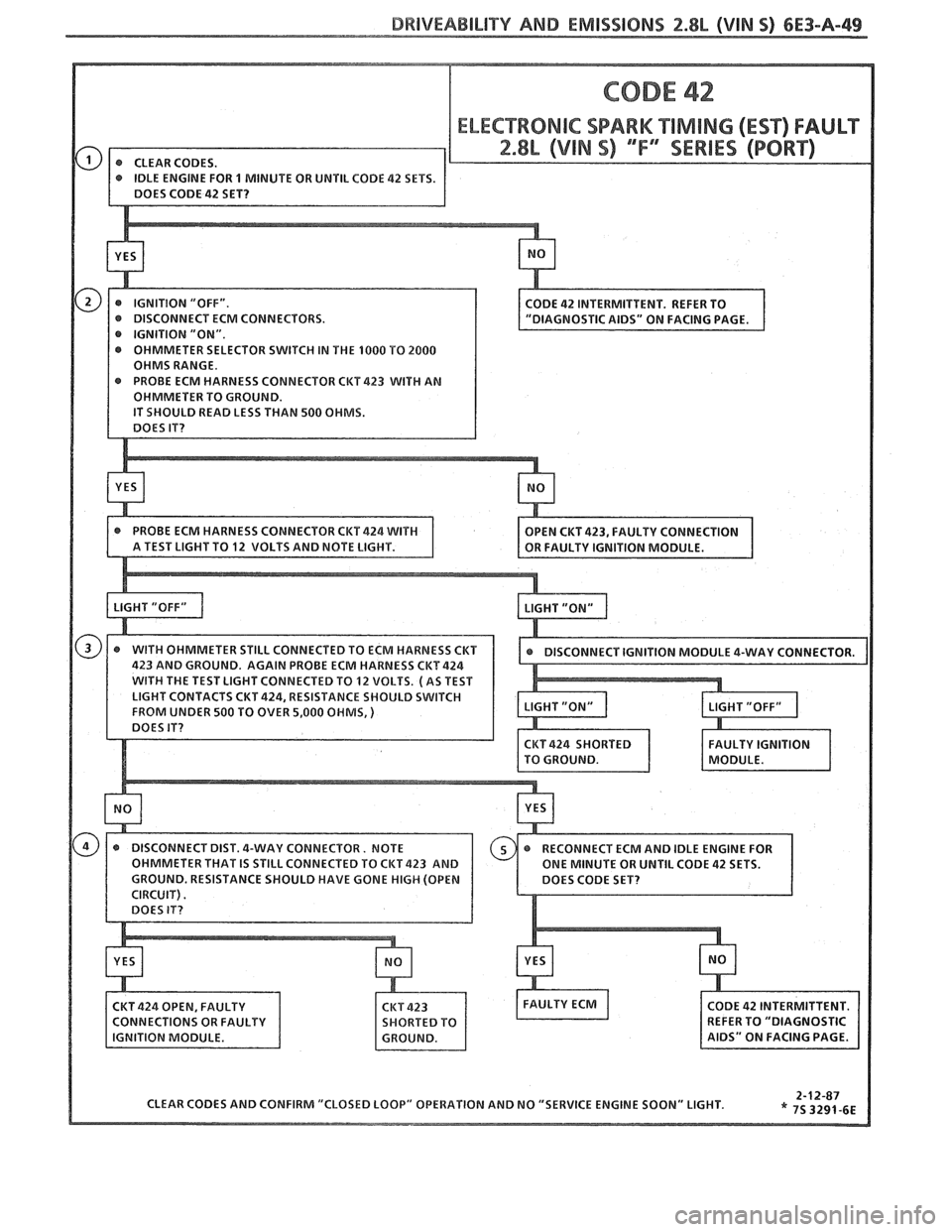
BWlVEABlLlTV AND EMISSIONS 2.8L (VIN S) 6E3-A-49
OHMS RANGE.
R TO GROUND.
READ LESS THAN
500 OHMS.
CLEAR CODES AND CONFIRM "CLOSED LOOP" OPERATION AND NO "SERVICE
ENGINE SOON" LIGHT.
Page 703 of 1825
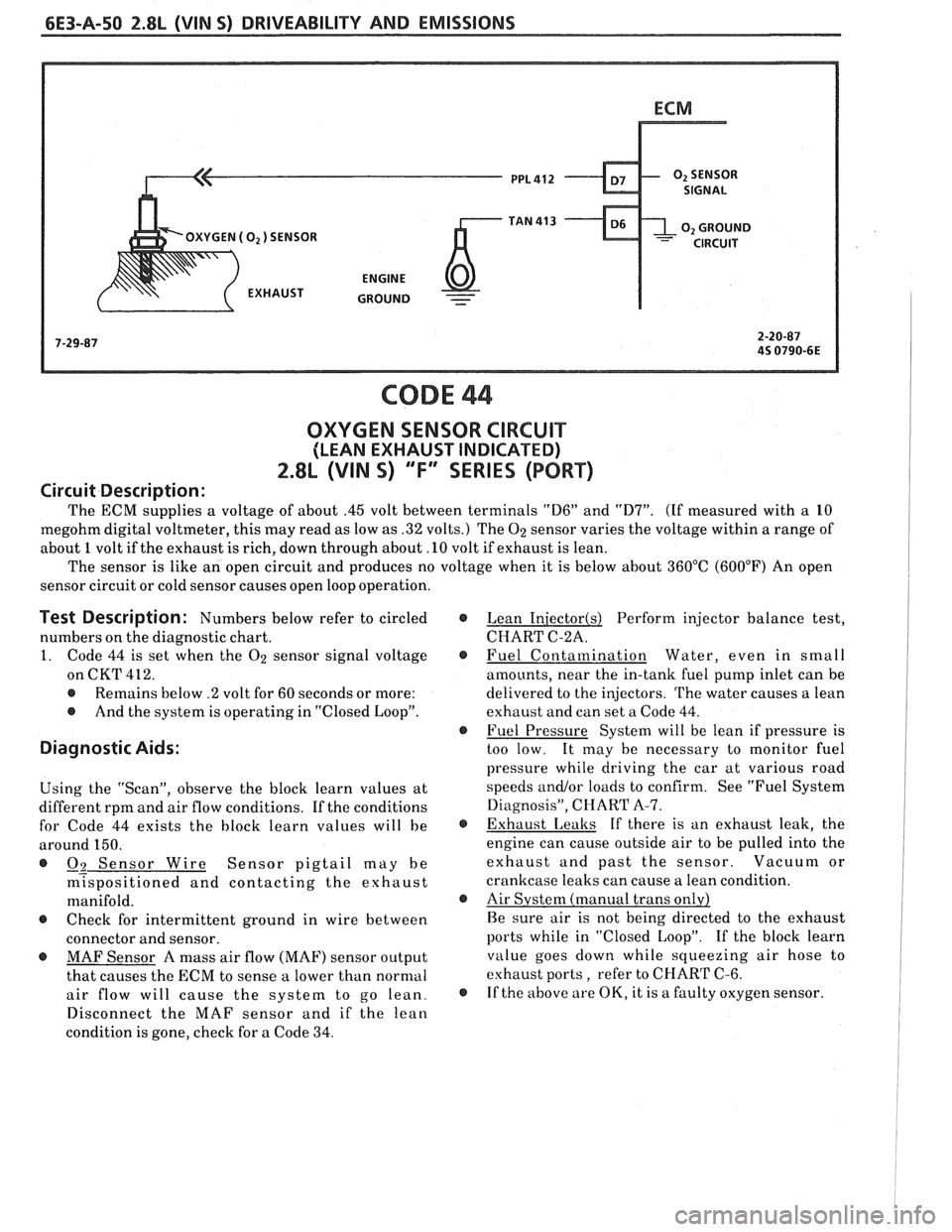
6E3-A-50 2.8L (VIN S) DRIVEABILITY AND EMISSIONS
OXYGEN (02) SENSOR
-
CODE 44
OXYGEN SENSOR CIRCUIT
(LEAN EXHAUST INDICATED)
2.8L (VIN S) "F" "SERIES (PORT)
Circuit Description:
The ECM supplies a voltage of about .45 volt between terminals "D6" and "D7". (If measured with a 10
megohm digital voltmeter, this may read as low as .32 volts.) The
O2 sensor varies the voltage within a range of
about
1 volt if the exhaust is rich, down through about .10 volt if exhaust is lean.
The sensor is like an open circuit and produces no voltage when it is below about 360°C (600°F) An open
sensor circuit or cold sensor causes open loop operation.
Test Description: Numbers below refer to circled
numbers on the diagnostic chart.
1. Code 44 is set when the O2 sensor signal voltage
on CKT 412.
@ Remains below .2 volt for 60 seconds or more:
@ And the system is operating in "Closed Loop".
Diagnostic Aids:
Using the "Scan", observe the block learn values at
different rpm and air flow conditions. If the conditions
for Code 44 exists the block learn values will be
around 150.
@ -- 09 Sensor Wire Sensor pigtail may be
m~spositioned and contacting the exhaust
manifold.
@ Check for intermittent ground in wire between
connector and sensor.
@ MAF Sensor A mass air flow (MAF) sensor output
that causes the ECM to sense a lower than normal
air flow will cause the system to go lean.
Disconnect the MAF sensor and if the lean
condition is gone, check for a Code 34.
@ Lean Iniector(s) Perform injector balance test,
CHART C-2A.
@ Fuel Contamination Water, even in small
amounts, near the in-tank fuel pump inlet can be
delivered to the injectors. The water causes a lean
exhaust and can set a Code 44.
@ Fuel Pressure System will be lean if pressure is
too low. It may be necessary to monitor fuel
pressure while driving the car at various road
speeds
andlor loads to confirm. See "Fuel System
Diagnosis", CHART A-7.
@ Exhaust Leaks If there is an exhaust leak, the
engine can cause outside air to be pulled into the
exhaust and past the sensor. Vacuum or
crankcase leaks can cause a lean condition.
@ Air Systenl (manual trans only)
Be sure air is not being directed to the exhaust
ports while in "Closed Loop". If the block learn
value goes down while squeezing air hose to
exhaust ports, refer to CHART C-6.
@ If the above are OK, it is a faulty oxygen sensor.
Page 704 of 1825
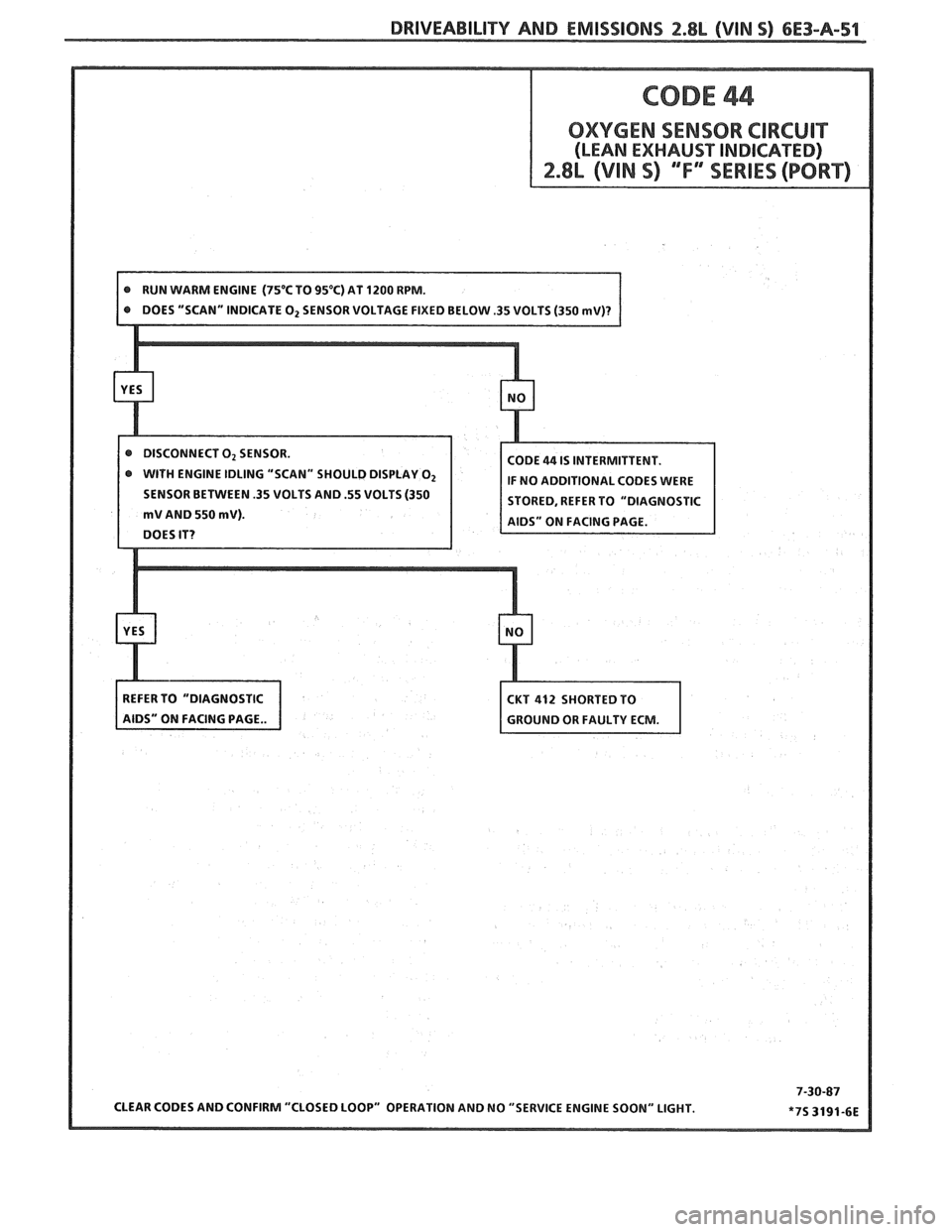
DRIVEABILITY AND EMISSIONS 2.8L (VIN 5) 6E3-A-51
SENSOR BETWEEN .35 VOLTS AND .55 VOLTS (350
mV AND 550 mV).
CKT 412 SHORTED TO
GROUND OR FAULTY ECM.
Page 705 of 1825
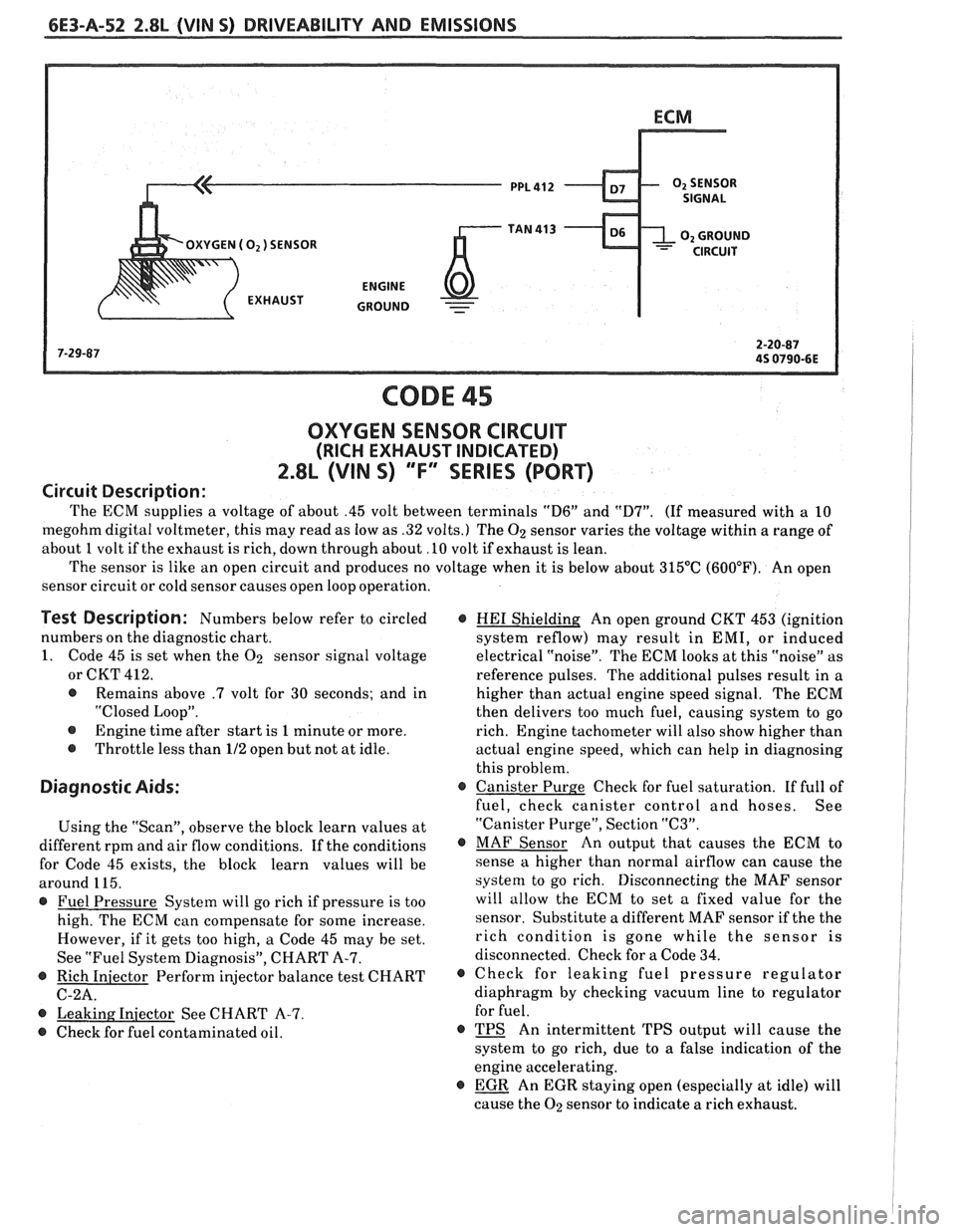
6E3-A-52 2.8L (VIN S) DRIVEABILITY AND EMISSIONS
- GROUND - -
CODE 45
OXYGEN SENSOR CIRCUIT
(RICH EXHAUST INDICATED)
2.8L (VIN S) "F" SERIES (PORT)
Circuit Description:
The ECM supplies a voltage of about .45 volt between terminals "D6" and "D7". (If measured with a 10
megohm digital voltmeter, this may read as low as .32 volts.) The
02 sensor varies the voltage within a range of
about
1 volt if the exhaust is rich, down through about .LO volt if exhaust is lean.
The sensor is like an open circuit and produces no voltage when it is below about 315°C (600°F). An open
sensor circuit or cold sensor causes open loop operation.
Test Description: Numbers below refer to circled
numbers on the diagnostic chart.
1. Code 45 is set when the
02 sensor signal voltage
or CKT 412.
@ Remains above .7 volt for 30 seconds; and in
"Closed LoopJ'.
@ Engine time after start is 1 minute or more.
@ Throttle less than 112 open but not at idle.
Diagnostic Aids:
Using the "Scan", observe the block learn values at
different rpm and air flow conditions. If the conditions
for Code 45 exists, the block learn values will be
around 1 15.
@ Fuel Pressure System will go rich if pressure is too
high. The ECM can compensate for some increase.
However, if it gets too high, a Code 45 may be set.
See "Fuel System Diagnosis", CHART A-7.
@ Rich Iniector Perform injector balance test CHART
C-2A.
@ Leaking Iniector See CHART A-7.
@ Check for fuel contaminated oil.
@ An open ground CKT 453 (ignition
system
reflow) may result in EMI, or induced
electrical "noise". The ECM looks at this "noise" as
reference pulses. The additional pulses result in a
higher than actual engine speed signal. The ECM
then delivers too much fuel, causing system to go
rich. Engine tachometer will also show higher than
actual engine speed, which can help in diagnosing
this problem.
@ Canister Purge Check for fuel saturation. If full of
fuel, check canister control and hoses. See
"Canister Purge", Section
"C3".
@ MAF Sensor An output that causes the ECM to
sense a higher than normal airflow can cause the
system to go rich. Disconnecting the MAF sensor
will allow the ECM to set
a fixed value for the
sensor. Substitute a different MAF sensor if the the
rich condition is gone while the sensor is
disconnected. Check for a Code 34.
@ Check for leaking fuel pressure regulator
diaphragm by checking vacuum line to regulator
for fuel.
@ TB An intermittent TPS output will cause the
system to go rich, due to a false indication of the
engine accelerating.
@ E]CR An EGR staying open (especially at idle) will
cause the
02 sensor to indicate a rich exhaust.
Page 706 of 1825

DRIVEABILITY AND EMISSIONS 2.8L (VIN S) 6E3-A-53
HARNESS CKT412 TO GROUND. IF
NO ADDITIONAL CODES WERE
0 "SCAN" SHOULD DISPLAY O2 BELOW STORED, REFER TO "DIAGNOSTIC
.35 VOLTS (350 mV).
CLEAR CODES AND CONFIRM "CLOSED LOOP" OPERATION AND NO "SERVICE ENGINE SOON" LIGHT.
Page 707 of 1825
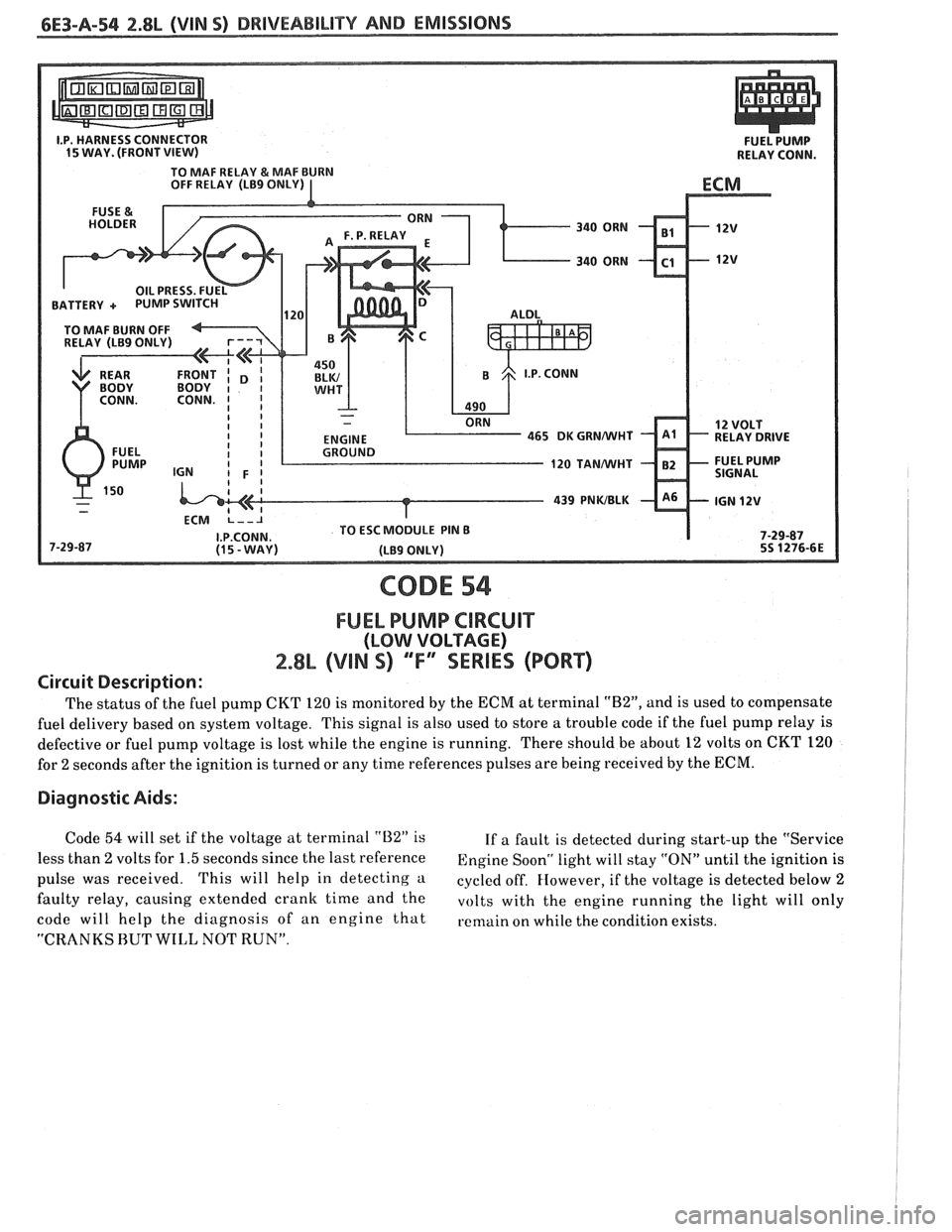
BATTERY + PUMP SWI
439 PNWBLK
CODE 54
FUEL PUMP CIRCUIT
(LOW VOLTAGE)
2.8L (VIM S) ""FYSERIES (PORT)
Circuit Description:
The status of the fuel pump CKT 120 is monitored by the ECM at terminal "B2", and is used to compensate
fuel delivery based on system voltage. This signal is also used to store a trouble code if the fuel pump relay is
defective or fuel pump voltage is lost while the engine is running. There should be about
12 volts on CKT 120
for
2 seconds after the ignition is turned or any time references pulses are being received by the ECM.
Diagnostic Aids:
Code 54 will set if the voltage at terminal "U2" is
If a fault is detected during start-up the "Service
less than
2 volts for 1.5 seconds since the last reference Engine Soonw light will stay "ON" until the ignition is
pulse was received. This will help in detecting a cycled off. However, if the voltage is detected below 2
faulty relay, causing extended cranlc time and the volts with the engine running the light will only
code will help the diagnosis of an engine that remain on while the condition exists.
"CRANKS HUT WILL NOT RUN".
Page 708 of 1825

DRIVEABILITY AND EMISSIONS 2.8L (VIN 5) 6E3-A-55
FUSED JUMPER
ENGINE
IDLING AT NORMAL OPERATING
Page 709 of 1825
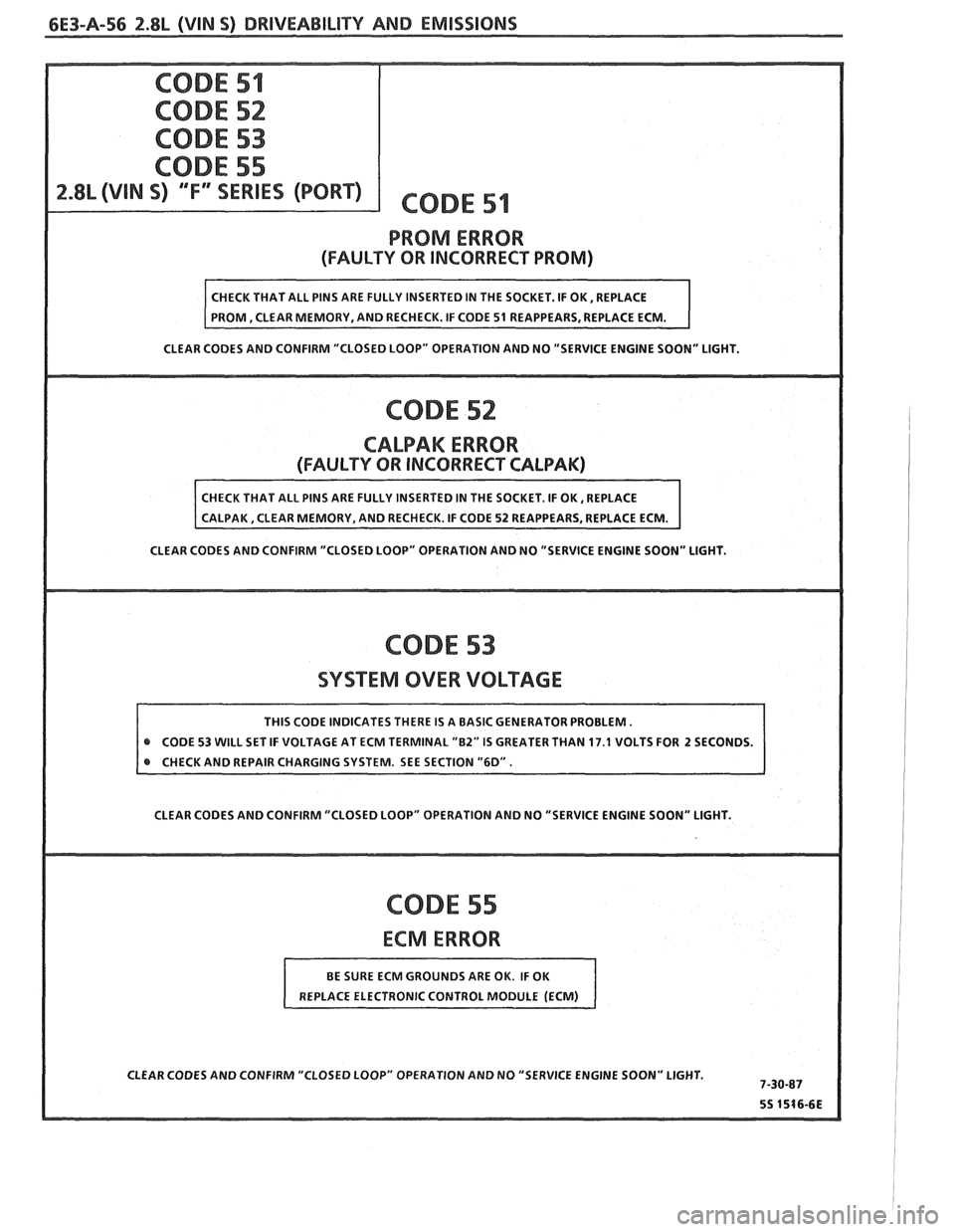
6E3-A-56 2.8L (VIN S) DRIVEABILITY AND EMISSIONS
PROM ERROR
(FAULTY OR INCORRECT PROM)
CLEAR CODES AND CONFIRM "CLOSED LOOP" OPERATION AND NO "SERVICE ENGINE SOON" LIGHT.
CLEAR CODES AND CONFIRM "CLOSED LOOP" OPERATION AND NO "SERVICE ENGINE SOON" LIGHT.
CODE 53
SYSTEM OVER VOLTAGE
@ CODE 53 WILL SET IF VOLTAGE AT ECM TERMINAL "82" IS GREATER THAN 17.1 VOLTS FOR 2 SECONDS.
@ CHECK AND REPAIR CHARGING SYSTEM. SEE SECTION "6D".
CLEAR CODES AND CONFIRM "CLOSED LOOP" OPERATION AND NO "SERVICE ENGINE SOON" LIGHT.
CODE 55
CLEAR CODES AND CONFIRM "CLOSED LOOP" OPERATION AND NO "SERVICE ENGINE SOON" LIGHT.
Page 710 of 1825

BRIVEABILIW AND EMISSIONS 2.8L (VlN 9) 6E3-B-1
SECTION B
SYMPTOMS
"TABLE OF CONTENTS
............................................................. Before Starting Page B-l
lntermittents............................................................... PageB-2
HardStart......,.......................................................... PageB-2
...................................................... Hesitation, Sag, Stumble Page 8-3
....................................................... Surges and/or Chuggle Page B-3
.............................................. Lack of Power, Sluggish, or Spongy Page B-4
...................................................... DetonationISpark Knock
Page 8-4
.................................... .................... Cuts Out, Misses ..O Page €3-5
Backfire............,...................................................... Page8-5
.......................................................... Poor Fuel Economy Page B-6
........................................................... Dieseling, Run-on. Page 8-6
........................................ Rough, Unstable, or Incorrect Idle, Stalling Page B-6
............................................. Excessive
Exhaust Emissions or Odors Page B-7
....................................... Restricted Exhaust
System Check (Chart 6-1) Page 8-8
BEFORE STARTING
Before using this section you should have
performed the DIAGNOSTIC CIRCUIT CHECK
and found out that:
1. The ECM and "Service Engine Soon" light are
operating.
2. There are no trouble codes stored, or there is a
trouble code but no "Service Engine Soon" light.
Verify the customer complaint, and locate the
correct SYMPTOM below. Check the items
indicated under that symptom.
If the ENGINE CRANKS BUT
WILL NOT
RUN, see CHART
A-3.
Several of the symptom procedures below call
for a careful visual check. This check should
include: ECM
grounds for being clean and tight.
@ Vacuum hoses for splits, kinks, and proper
connections, as shown on Emission Control
Information label.
@ Air leaks at throttle body mounting and intake
manifold.
@ Air leaks between MAF sensor and throttle
body.
Ignition wires for cracking, hardness, proper
routing, and carbon tracking.
@ Wiring for proper connections, pinches, and cuts.
The importance of this step cannot be stressed
too strongly
- it can lead to correcting a problem
without further checks and can save valuable time.